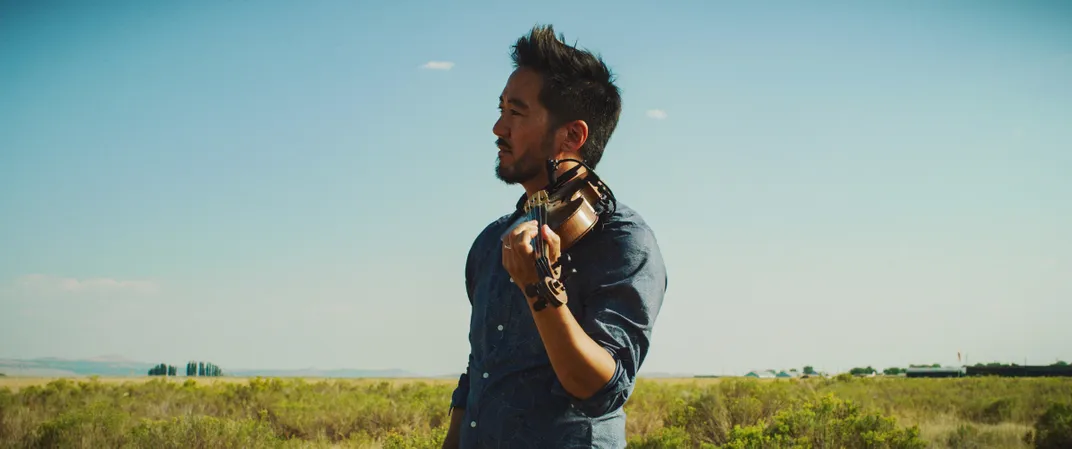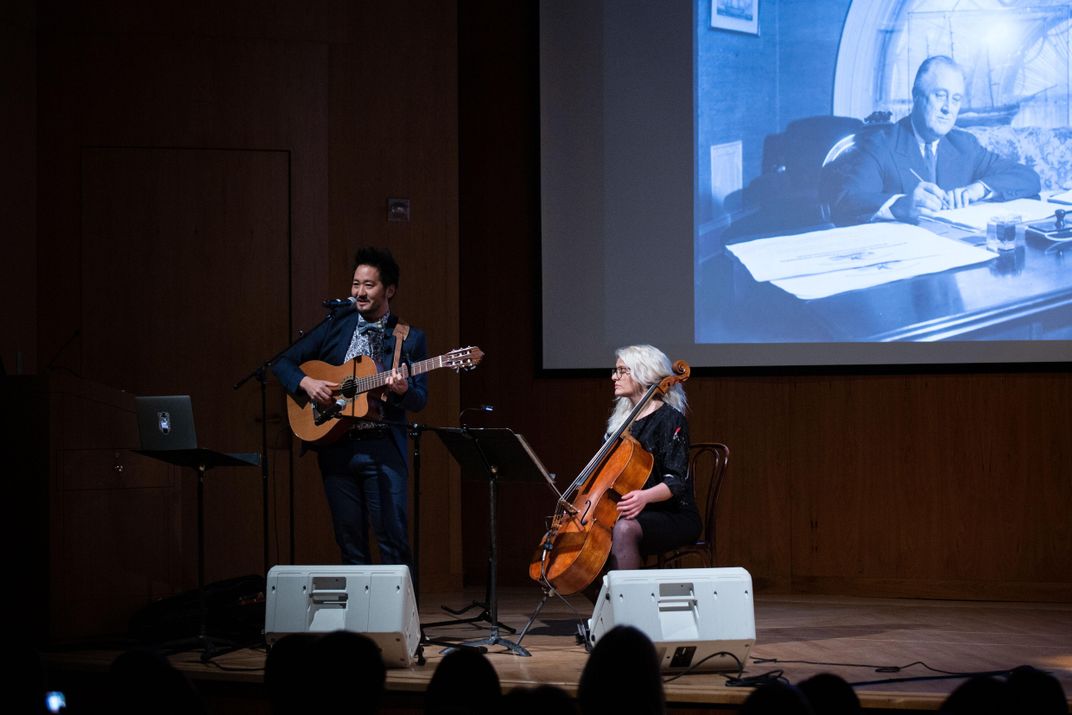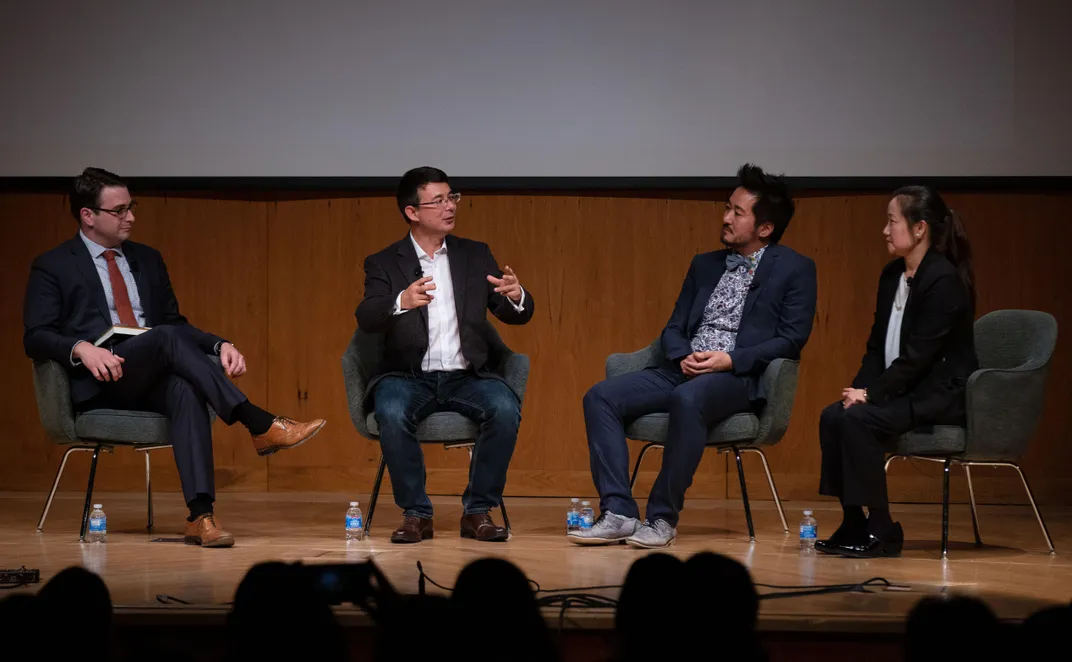Kishi Bashi on Turning Hard History Into Memorable Music
Plus, listen to an exclusive debut of ‘Marigolds’ off his new album, ‘Omoiyari’
Since he was 13, Kaoru Ishibashi has been known among his friends as K. Ishibashi. That’s how he came up with his stage name, Kishi Bashi, which, if you sound it out, is just a combination of his first initial and last name. Lately, though, the experimental indie pop star—now 43—has been rethinking things. “Kaoru is my real name,” he says. “It’s kind of hard to pronounce. You’ve got these two vowels next to each other. But I think it’s the kind of thing we should be able to start pronouncing.”
Ishibashi, a violinist and singer-songwriter, whose ability to soulfully build complex, layered sounds into pocket symphonies had NPR hailing him as a “one-man orchestra” after he launched his solo career in 2012, has been giving a lot of thought to his identity since he began work on Omoiyari, the title of both his fourth studio album (dropping May 31) and a feature-length “songfilm” of the same name that he’s composing and directing. Both respond to the history and memory surrounding Japanese American incarceration during World War II with an eye toward the present-day.
Just 48 hours after Japan bombed Pearl Harbor on December 7, 1941, Americans of Japanese descent began being rounded up by the U.S. government. Executive Order 9066, signed into law by President Franklin D. Roosevelt roughly 11 weeks later, ultimately affected the lives of 120,000 people. Most were given a short window of time, 48 hours or a week, to pack what they could carry before they were sent away from their homes to incarceration camps like Tule Lake, Manzanar and Rohwer, where they were forced to stay, on an average, for three to four years during wartime.
Ishibashi’s family didn’t experience this chapter in history, as they emigrated from Japan to the U.S. after the war, but he was familiar with the events through textbooks and his parents' own efforts (they lived in Norfolk, Virginia, when he was in high school, and he particularly recalls one memorable trip to D.C. to see an exhibition on the camps at the Smithsonian). Following the 2016 presidential election, though, he began thinking about the experience of those 120,000 Japanese Americans incarcerated during the war with renewed ferver. “There’s a lot of contemporary parallels now, like the Muslim ban and Islamophobia and basically using fear and hysteria to fuel these outsider xenophobic ideas,” he says. Taking the themes he usually worked with—love, loss and desire—he set about doing something different this time: infusing them with a historical narrative.
Noriko Sanefuji, a museum specialist at the Smithsonian's National Museum of American History, met Ishibashi as he traveled around the country, speaking with survivors, visiting former camps, and learning from academics. During the annual Heart Mountain Pilgrimage last year, they stood together with an estimated 300 people, many of whom were formerly incarcerated at the campsite or were related to family who had been. There, she says, the history of the incarceration camps feels especially alive. “The World War II generations are passing, but the grandkids are there, so it’s part of their history, and it’s part of our American history, too,” she says. “It was really, really powerful, very moving to be in that space at that time.”
After hearing Ishibashi perform (you can listen to it live on podcast Order 9066), Sanefuji invited him to take part at an event held at the museum earlier this year for Day of Remembrance, which marks the anniversary of the signing of the executive order. She says she sees Ishibashi, who has a daughter of his own, now in her teens, as one of the people who can help make this history feel accessible and relevant to future generations. “I feel he works as a bridge,” she says.
For the work he's doing, he's selected the Japanese term omoiyari. While it doesn’t translate easily into English, if you break it down, it’s made up of two verbs “omou,” which means, roughly, to “think or feel” and “yaru,” or “to do, to give, or to undertake.” The combination suggests empathy but also action, the right encapsulation of what he's devoted himself to the last two years.
In advance of his album release, Smithsonian.com spoke with Ishibashi about his process putting Omoiyari together.
There’s so much history to cover. How did you begin researching Omoiyari?
I spent a couple months just reading a lot, just catching up. Fortuitously, I joined a group of Brown University graduate students. They had organized this two-week trip on the west coast to Manzanar, Tule Lake, and the Japanese American National Museum to talk to survivors. They’re graduate students, so they have discussions talking about this all day long and then continue talking about it over a beer at night. So that was the beginning of it.
You've cited the No-No Boy project, which describes itself as an immersive, multimedia work of archival images, stories and songs, as being particularly influential.
Yes, [No-No Boy founders] Julian Saporiti and Erin Aoyama are doctoral candidates at Brown. I think Julian interviewed me once, and we really connected. Without him, I don’t think I would have felt comfortable going on a trip for two weeks with strangers that were 20 years younger than me. They’re of the same idea that education in a vacuum isn’t enough. That you need to get out and bring in people who aren’t in your own circle to understand the message. You can do all this research and create cutting-edge ideas, but if you don’t sing songs or tell stories or engage a larger audience, a lot of these ideas can get lost.
Talk to me about the songfilm you’re working on in conjunction with the album. Why did you decide to create a full-length documentary?
The idea is that the music is a binding glue that engages the audience to digest this really difficult history. The more your personality is in it, the more likely people are willing to get into your story. So that’s what I’m trying to do. To get people in with beautiful music or some kind of compelling theme to tell the history and drive these ideas about minority identity in the country.
What’s it like to turn history into art?
It’s a challenge. I went to museums, I read books. I talked to historians. Ultimately, it’s difficult to write songs about the ’40s. But I do have connections to the raw emotions like fear and love and celebration. These are things that are universal.
I always had a problem of including Japanese peoples’ names [in my songs.] Maybe I was afraid to stick out as not white. But one of the songs [on the new album, “Violin Tsunami”] is in Japanese and I’m not afraid as much anymore.
What was the hardest song to write?
“Theme for Jerome” is very emotional for me because that’s the loss of language and intergenerational communication. Japanese-Americans would be forced to just use English as a way of survival. So that means a grandfather who doesn’t speak much English can barely communicate with his grandchildren. That’s heartbreaking for me, [as someone who] can communicate with my relatives in Japan because I do speak Japanese.
Thinking about those intergenerational connections brings me to “Marigolds,” which we’re thrilled to debut. Do marigolds symbolize anything? I always think about them in relation to Day of the Dead, and the petals that link living families to their ancestors.
I don’t like to divulge completely about what it’s about. But I think, yeah, in [the Disney film] Coco, [the characters] talk about how you’re only alive as long as you’re remembered. The spirit dies when you forget about it. That’s a beautiful idea. I can see the way history is like that. Like the uncle you never met, but you can imagine who he was, and that’s how his spirit stays alive.
In Japan, we have ancestor worship. I went to Tokyo to film a little bit of [Omoiyari] and my grandmother was talking about it. She said you pay respect [to your ancestors] because you’re here because of them. Because of their grace, we’re here now. They survived and they put a path of life for us. I thought that was really beautiful.
Who’s been the most memorable person you’ve met working on this project?
Julian and Erin of the No-No Boy project. They represent this optimistic—well, Julian’s a little salty—but Erin is a beautiful spirit, and she represents this optimistic outlook that I think we share on the next generation. I’m very optimistic. I have a 13-year-old daughter and I see her generation being more empathetic, more compassionate, more considerate, more tolerant. That’s the kind of thing that makes me encouraged.




